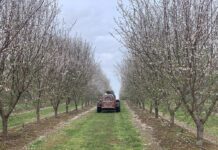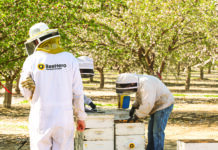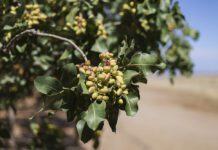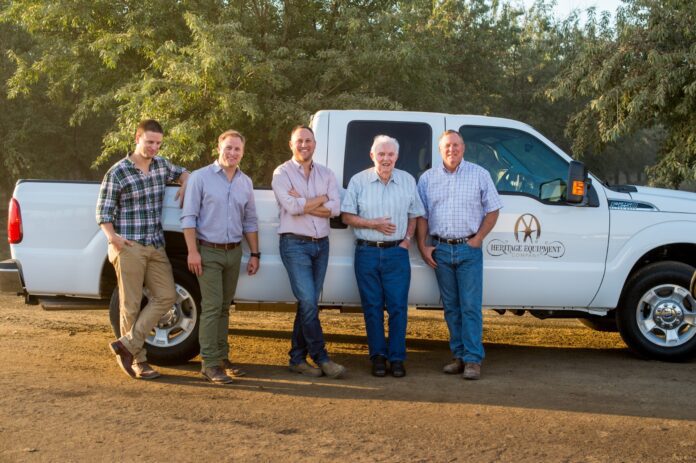
James Gardiner leans back in his chair and talks about bees. It’s a topic he’s plenty familiar with. He spent the last 10 years running his family’s honeybee operation, which gave him a different perspective on the almond-growing business.
Seeking a new perspective has been a driving force in Gardiner’s life since he graduated from college. After playing baseball in college (where he got two hits off of future two-time Cy Young winner Tim Lincecum) and graduating with a degree in business marketing, Gardiner told his dad he wanted to take five years to experience the world outside of farming and to see the farming business in a different light. He wanted to understand the financial side, delve into marketing and experience the creation of an end product.
After stints with a wealth management company and doing marketing for a regional Nissan office, he landed at Pereira O’Dell just at the beginning of the social media boom.
“I was on the business development side, and I got to see that whole social media space blow up back when a million views on YouTube was something amazing,” he said. “It gave me a very unique look into something completely different.”
To experience the creation of an end product, Gardiner then found an opportunity at Chez Panisse, a renowned farm-to-table restaurant.
“It was my second-hardest job other than pulling pipe in the fields,” he said.
The job was fulfilling and ticked off the last item on his list. When he was ready to return to the farm, honeybees were a hot topic in the news, even appearing on the cover of Time Magazine. His family made the decision to purchase a honeybee operation, and Gardiner spent the next 10 years making a circuit with their honeybees.
“It’s a 20,000-hive operation based out of North Dakota where we primarily focus on almond pollination,” he said. “We’ll hit cherries. Grab some pollen from pomegranates and then run out to North Dakota, where we make a honey crop, and we do the loop all over again.”
In the past year, Gardiner has returned to his almond-growing roots, adding more growing-related responsibilities to his honeybee responsibilities in his role as vice president of Pacific Ag Management.
We asked him to share his thoughts on family farming and the nut industry with West Coast Nut.
Q. Start by telling me just a little bit about the history of your farming operations.
My grandfather was leasing some ground he had developed from Sagebrush. He lost the main lease in the summer of ’69 and had to go back to 100 acres. That’s kind of where he sat for a while. When my dad graduated from Cal Poly in ’78, he actually was given a job offer because it really wasn’t much acreage for him to come back to. But my grandfather really wanted him back, so they ended up making a deal. My dad’s one caveat was he didn’t want to lease any more ground. He wanted to figure out how to buy it. So, they started their partnership. They planted their first almond orchard in ’82, which was the year I was born.
So, we’ve been growing almonds since 1982, along with some row crops that have kind of gone by the wayside. And now that farm has grown to just over 22,000 acres under management of almonds and pistachios. We have a honeybee company that’s based in North Dakota. We also run a cow-calf operation up in the hills just inside the Kern County boundary, about 1,200 cows.
Q. How has farming changed just in the 10 years that you weren’t hands-on involved with it?
Well, I think I’ll start with the honeybees because that’s a little bit easier. There’s a bigger change there. One, the price has gotten to a fairly reasonable price at $200 a hive, or to $220, $225, where beekeepers can get a little excited and make an opportunity for themselves if they can provide quality bees year after year.
It hasn’t gotten easier. Montana and South Dakota have restrictions on how you set bees, nobody can go within a few miles of you. [In] North Dakota, it’s the wild, wild west, where in those last 10 years we’ve seen severe drought, and in that time period, the guys from Montana and South Dakota that were droughted out just started sending their bees to North Dakota. They’re not necessarily paying property taxes, but now they’re placing their bees on North Dakota, and they’re taking away from our honey crop, from our bees that are going to need that extra pollen where everything’s just crowded. But that’s where I’ve kind of seen the last 10 years is basically just drought-related.
Because that also relates to the farm side, which we’re all just trying to deal with SGMA, and really what that’s going to do to us, and how fast that has come. But then on the flip side now, the last couple of years of the amount of rainfall we are seeing, and I sit here just knowing, just from being in farming, that these peaks and drops come, and we still haven’t fulfilled on our amount of reservoirs that we needed for the State of California.
That plan was put in 70 years ago. We still haven’t fulfilled on that. And that was based on a population of 30 million people. And I think we’re still three reservoirs shy from what that original deal was. And back then, 70 years ago, they knew we had peaks and troughs, and we had atmospheric rivers, and when it dumps water, you’d better save it. More legislative restrictions placed on [growers] has forced us as a family farm to get bigger or die.
You have to start playing in a bigger world, and you’re against a lot of tough forces. As you get bigger, you have to get more professional, and what I’m seeing right now is a lot of the family farms aren’t willing to keep putting up with the bureaucratic mess, simply raising their hands up in the air and going away. And it’s very sad to see in the State of California.
It really is because there are so many family farms up and down the state, and I just see the state wanting to reduce the number of family farms and push them more toward corporate farming, corporate goals, and if we want to survive, we have to try to keep getting bigger.
Q. Talk a little bit about that process, that change from starting with 100 acres to now 22,000 acres. How does that change the way you farm or the way you deal with all of the things around farming?
Actually, my dad has been the growth driver of the business, putting the ideas and deals together. I view my brothers and I and our whole executive team as the executors. Day in and out we implement the in-field practices that support the deal.
What it turns into a lot now is trying to build out a company with better procedures and policies and figuring out how to treat our people correctly. How can we develop them into leaders? Because as you grow and grow and grow, you bring on more employees.
And the largest task is figuring out how to manage large blocks of employees and get the type of productivity that you would expect out of a smaller farm and keep the quality that you do on a smaller farm, where you can have more attention to detail. But with more people, it is definitely harder to manage, especially coming up from a family farming mentality. That mentality is more of a, “Just get in there and do it yourself” vs learning to develop employees with you that can tackle those tasks the way you would like to see them tackled.
Q. What is it like working with family and growing the family operation?
Going back to the conversation of we’re kind of being forced to get bigger. This has been ingrained in our heads since we were young, but my dad, when he came back to 100 acres and was trying to build everything out, he had three sons. All he hoped for was that he could provide an opportunity for his sons or family members to be involved in the operation, but the only way you can do that is through growth.
Thankfully, we are of a size now that has supported three brothers, three sons, coming into an operation but also an operation of some scale to where we can get involved in different aspects. The first 10 years of any of us being back, we were in different locations, working on different pieces of the farm. John on the equipment. Me on the honeybees. My brother out in the sales and marketing. We didn’t rub elbows. We learned to work with people and on our own. We weren’t fighting amongst each other. We were able to develop our own style. And now, 10 years later, we’re at an age with our own families that now we see a common alignment among each other of keeping this thing going. And how can we keep this going is a common question we ask ourselves.
Q. What are the three things to keep you up at night related to the farm?
The No. 1 concern is overwintering of the bees because there’s a natural die off during that period. So, what are we going to be able to have in place for pollination in February?
Two is water and legislation that can be enacted in the living and working environment of California.
Three, right now, has been almond prices and honey prices.
Q. Talk a little bit about the water situation, how you’re approaching that and how that has affected decisions you’re making.
We’re just starting to see some of those restrictions come down through the different water districts, and the No. 1 way they’re coming down is through cost increases of that water.
We’re having to step back and assess the long-term viability of these ranches that are planted and that need water and having to take a realistic look at whether in 20 years, will we realistically be able to farm, and at what price? It’s not as simple as taking things out of production because you’re still going to have to carry the property taxes on that land that is fallowed. You’re still going to have the burden of those costs. So now you’re burdening your operating farm with increased costs from fallowing. You’re having to look at some diversification, maybe opportunities… in solar.
The solar guys are waiting to see if there’s funding from the government. We’ve seen the waves in solar, and it’s all dictated by funding from the government. It’s not really a self-sustaining diversification, I would say, because without that government support, the solar panels really don’t get put on the farms the way they have.
We’ve had to look at solar just around our ranches because of the increase in electricity costs, and those are big factors when you start to put orchards together that are going to have a lifespan of 25 to 30 years.
Q. What makes you hopeful for the future when it comes to the tree nut industry?
I’m hopeful with the industry because we’re growing a great product, a healthy product.
Q. Talking about the problem of not a lot of young people wanting to come into farming, do you have any thoughts on how to make that more appealing for young people?
Agriculture has always kind of been behind on the curve of technology. Having experience in San Francisco, or living in L.A., the amenities that attract that young, talented group, they go there first. They’re chasing technology. They’re chasing the amenities of the big city. And as far as large farming areas, they haven’t been the first choice of areas to live in. But it is those small cities, whether it be Bakersfield or somewhere else stepping up to the plate, I think people from L.A are starting to realize Bakersfield isn’t a bad place to live.
It’s not a bad place to start a career. It’s just over the hill, and you have the access to the Sierras. We have the beautiful Kern River. You’re just two hours from the beach. So, some of those things, when it comes down to attracting talent or attracting people into the industry, is bringing a little bit higher level of a job that might be a little bit more technology-based, which is slowly coming into ag, and it will probably continue to come quicker.
And then it’s those mid-career people, I guess, that would be afraid to switch to ag. But there has to be a realization that that outside experience they’ve had in tech or accounting at a big accounting firm comes right back down to these larger agriculture companies that need younger people with that extended knowledge to bring that back and enhance the farms we have today. Because, like I said, they’re forced to get bigger. And you have to get better and smarter with that outside experience. I would encourage anyone to look into the agriculture community.
Q. What kind of advice would you give to a young person looking to get into farming today?
It’s not going to happen. Sadly, just the capital cost to get into farming is an obstacle.
One way I would look at it is not necessarily farming, but you want to be in the agriculture industry. You’re probably not going to come in and be a [grower].
College-educated kids that are wanting to be a farm supervisor and kind of come up through the ranks are needed. But it is a tough job market. There’s not a lot of positions available.
If you want to come into the agriculture industry, whether it be the finance/accounting side, maybe in the marketing world, I would say it’s more attractive. I would push any young person to go try it.
But to come out and try to be a young farmer, buy a piece of land, buy the equipment, in the environment today, it’s a tough road ahead, sadly.
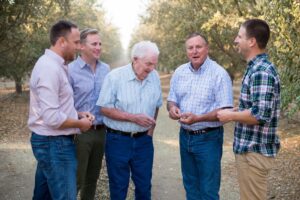
Q. With your marketing background in mind, talk a little bit about how tree nut marketing is evolving.
Let me start that off with just a little bit more of an overview of how we’re set up. I’ve been over the honeybees for the last 10 years. My brother John has been over the equipment side, and now he’s stepped into the overall management as president of Pacific Ag Management and our Gardiner family of companies. Joe Gardiner, our youngest brother, works out at our processing facility, TreeHouse California Almonds, and he’s in the day-to-day sales and marketing.
On the marketing side, everything we do goes through TreeHouse California Almonds, which has a great name within the industry. High quality, great food safety background, and that all starts in the field.
What we really like to do with TreeHouse is be able to tell the story from the ground all the way through the processing side. A lot of people do not have that story to tell. It’s not as easy if you go to some of the other processors where they’re getting almonds from many different ranches. That story just doesn’t connect as well.
Being able to utilize that with the brands we interact with is important. We have something in place right now called The Almond Project. That has been a program that has been set up specifically on the farm, working with a small group of brands that wanted to dive into regenerative agriculture.
So, us being the [growers], we are the ones that are able to help facilitate by taking their ideas and pushing back on them when they don’t make sense. I think in the almond industry, one of the ones we kind of pushed back on was just cover crops. Everyone wanted cover crops. It was being pushed by everyone, and I’ll just give you an example.
It does make some sense. But from my perspective on the beekeeping side, with almonds you normally have two to three different varieties of almond trees. That’s three different sources of pollen already, three different sources of protein, fats and carbohydrates, and each of those pollens in those different trees have a different set of amino acid profiles. We’re able to push back in this regenerative program about what is that really doing for us?
And we’re looking at the water penetration from the cover cropping. Does it really make sense on a large scale because you have so many more issues? When I think of cover cropping and the marketing of this, yes, it sounds good, but it also has to work on a farm for it to be marketed for a long period of time. No. 1, when I think of cover cropping, it’s just another pass. It means we’re using more diesel, there’s more wear and tear on another tractor and more labor hours. Because at some point you’re going to have to come back and kill that cover crop. So, ultimately, what are you trying to do for the environment? Do you need that other pass along all these orchards?
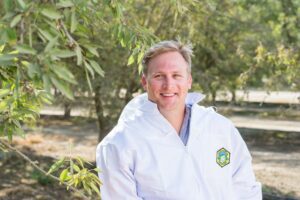
But back to the marketing aspect, we’re trying to dive in deeply with brands about how they can connect with their consumer. Whether it be our family message about how my brothers and I are still on this family farm, working on it every day alongside our dad and our grandfather, who just passed away at 101. Or we connect with brands by working toward in-field solutions that help them tell the story of sustainability directly to their customers.
Q. What role will technology play in the future of tree nut farming?
Where I focus our technology right now is on the back-end systems, the back-end reporting. As the companies get larger, you have to get more efficient, and the way you do that is to get information from the field and into your accounting department where we utilize it.
I get pretty excited about this. It’s as simple as building our apps in-house for guys out in the field to use on a daily basis. We can have our shakers go out, and we can track how many trees they’ve shook vs barked. And the guys that are barking less and shaking more, it’s, “Hey, we got some good guys. Let’s take care of them. How do we encourage more of that?”
So, it’s getting that information down from the field all the way up the chain. It’s utilizing the technologies, such as apps, or the reporting methods of how we visualize that data for managers to make better decisions in the field.
I mean, we’re going through such a fast pace right now with the amount of information we’re getting and being able to compile it. Looking at timing of different sprays or insect damage, breaking that down by the block is getting very exciting. And we have all that information.
Automated shakers or sweepers. They’ll come when they come, and we’ll be ready for them.
Q. How do you and your farm give back to the community?
My dad started this thinking, an understanding that if you can enrich the lives around you with a good-quality place to work, producing a quality product, it just goes very deep into the local communities, the smaller communities that sit right outside of Bakersfield. That’s where our employees are coming from.
We are all providing for our own families. We don’t want to see these jobs go away. We don’t want to see our little towns go away, so as giving back the No. 1 thing I would point to is making sure we’re maintaining and caring for the ground that we own or manage so those resources of that land can continue on for a long time, continuing to provide jobs for smaller communities. As a family, we support CASA within Kern County.







